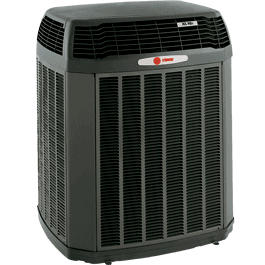If you’re in the market for a new, more efficient air conditioner, you’ve likely come across the SEER numbers for the heating and cooling systems. You might have even seen SEER2, which is the new standard rating as of January 1, 2023.
But what do these ratings actually mean? What do they tell you about the energy efficiency, cooling output, or energy cost for these HVAC systems? Let’s dive into those questions, so you can be sure that you’re getting the right heating or air conditioning unit for your home.
What is SEER?
SEER is a standard for gauging an HVAC system’s energy efficiency. SEER stands for Seasonal Energy Efficiency Ratio—the higher SEER rating, the more efficient the air conditioners and heat pumps will be.
A SEER rating is calculated by measuring the ratio of the cooling output of an air conditioner and heat pump over a typical cooling season, divided by the energy it uses in Watt-Hours.
It’s important to note that SEER ratings are for the air conditioning units’ maximum efficiency (similar to your car’s miles per gallon rating), and could lower depending on conditions.
What is the SEER Rating for Air Conditioners?

Higher SEER units will cost more upfront, but the advanced technology that comes with higher performance will yield better temperature control, more comfort, and better energy savings.
Air conditioners on the market today will have a SEER rating with a range from 13 to 25, and the average central air conditioning system sold has a SEER rating of 15 to 18. The minimum SEER rating in Canada is 13 SEER, and AC units with a SEER rating of 14.5 or higher will have an Energy Star designation.
If you’re ready to beat the heat with a new air conditioner unit, give us a call!
What is the SEER Rating for Heat Pumps?
Heat pumps are both a heating and cooling system, and so there are slightly different methods of measuring each of these functions.
For cooling mode, heat pumps use SEER and SEER2, just like central air conditioners do.
For heating mode, heat pumps use HSPF (Heating Seasonal Performance Ratio 2) to measure its heating efficiency.
Just as with your air conditioner, a good SEER rating changes as technology advances. The minimum SEER requirement in 1992 was as low as 10, but now standard SEER2 ratings are around 14.3.
SEER vs. SEER2
A SEER rating is measured over an entire cooling season, using a constant indoor temperature and a range of outdoor temperatures (simulating a typical season). The higher the SEER rating, the less energy the air conditioner will use.
The biggest difference between SEER and SEER2 is the testing conditions for each rating system. Factors such as external static pressure, as well as the home’s current ductwork system, play a major role in representing the conditions in which your AC unit will be operating. SEER2 takes these into consideration, whereas the old SEER rating system did not.
Install Your High-Efficiency AC Today!
While SEER and SEER2 are factors to consider when you’re looking for an HVAC system with greater energy efficiency, they aren’t the only characteristics that will have an impact on cooling efficiency.
You’ll also need to consider the BTUs, whether an air conditioner is one-speed or two-speed, the cost of running the AC unit, and the size of the unit.
While there are several factors to think about when purchasing a new HVAC system, including price, size, and cooling capacity, the long and short of it is that a higher SEER rating equates to a more energy efficient system.
If you’re concerned with how much energy your new air conditioning unit will use up, get the system with a high SEER rating that lies within your budget. You can cut down on your energy bills in other ways, but the biggest bang for your buck will be with a high efficiency system.
Contact Knight for a free quote on your next high efficiency cooling system!






